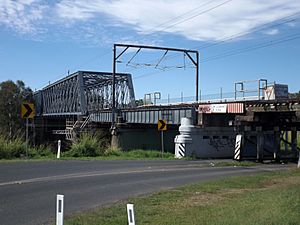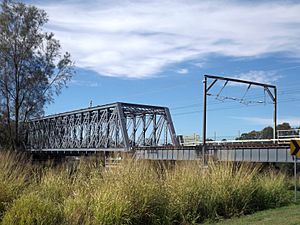Sadliers Crossing Railway Bridge facts for kids
Quick facts for kids Sadliers Crossing Railway Bridge |
|
|---|---|

Bridge in 2015
|
|
| Location | over Bremer River between Tallon Street, Sadliers Crossing and Dixon Street, Wulkuraka, Queensland, Australia |
| Architect | Henry Charles Stanley |
| Official name: Sadliers Crossing Railway Bridge | |
| Type | state heritage (built) |
| Designated | 13 November 2008 |
| Reference no. | 602569 |
| Significant period | 1902 |
| Lua error in Module:Location_map at line 420: attempt to index field 'wikibase' (a nil value). | |
The Sadliers Crossing Railway Bridge is a special bridge in Queensland, Australia. It carries trains over the Bremer River. You can find it between Tallon Street in Sadliers Crossing and Dixon Street in Wulkuraka. This bridge is part of the important Main Line railway, which is now known as the Ipswich and Rosewood railway line. Because of its history and design, the bridge was added to the Queensland Heritage Register on 13 November 2008.
Contents
Building Queensland's Railways
The Sadliers Crossing Railway Bridge was built in 1902. It was designed by a famous engineer named Henry Charles Stanley. This bridge is actually the second one to cross the Bremer River at this spot.
In the 1860s, the Queensland government decided to build railways. They wanted to make it easier and cheaper to move goods and people. Roads were very bad back then. The first railway line was planned to connect the important farming area of the Darling Downs to the coast.
The town of Ipswich was chosen as the starting point. It was a major river port and a good spot for connecting different routes.
Starting the Railway Network
Queensland started its railway system in 1863. The first part of the railway was from Ipswich to a place called Bigge's Camp. This section was about 21 miles (34 kilometres) long. The government chose a special narrow track width of 3 feet 6 inches (1,067 mm). This width became standard for Queensland's railways.
Construction began in February 1864. The first section of the line opened in July 1865. This early route from Ipswich was a bit different from today's line. The Ipswich station was further north, and the line crossed the Bremer River right away.
The railway line was then extended to Gatton in 1866 and then to Toowoomba by May 1867. This made it possible to travel over the Main Range.
Upgrading the Main Line
The railway line from Ipswich to Grandchester was very important. In 1875, a new, shorter line was built. This new line crossed the Bremer River west of Ipswich at Sadlier's Crossing. This change was part of extending the railway line from Brisbane to Ipswich. The old line was kept to serve the railway workshops in North Ipswich.
Over time, the railway needed improvements. Around 1891-1892, the old iron rails were replaced with stronger steel rails. All the bridges on the Main Line were also upgraded. This was so they could carry much heavier trains.
In 1899, it was decided to add a second track between Ipswich and Wulkuraka. They also planned to raise the Sadliers Crossing Rail Bridge. This was to prevent floods from covering it, like what happened in the big floods of 1893.
Designing the New Bridge
The new Sadliers Crossing Railway Bridge was designed by Henry Charles Stanley. He was the Chief Engineer for Queensland Railways from 1892 to 1901. Stanley was a very important engineer in Queensland's history. He was born and trained in Scotland.
During the 1890s, many large metal railway bridges were built. These bridges helped connect important towns and resources across major rivers. They were vital for the transport system and for the development of the whole state. Many of these early bridges have since been replaced.
Building the Bridge
The company J McCormick and Sons won the contract to build the Sadliers Crossing Railway Bridge. Work began in February 1900. The timber parts of the bridge were finished, and the steel plate girder spans were in place by 1901.
The bridge was completed in March 1902. The current bridge over the Bremer River at Sadliers Crossing then started being used. It had two tracks. One track went towards Rosewood, and the other was for the Brisbane Valley branch line.
What is a Whipple Truss?
The Sadliers Crossing Railway Bridge uses a special design called a Whipple truss. This design is a stronger version of another design called the Pratt truss. The Whipple truss is also known as a "Double-intersection Pratt." This is because its diagonal parts cross two sections, while the Pratt truss only crosses one.
The Whipple truss was very popular for railways. It was stronger and more stable than the Pratt truss. The Sadliers Crossing Railway Bridge has the second longest Whipple truss span in Queensland. The longest was the former Burdekin River Rail Bridge.
Later Changes to the Bridge
In July 1914, work began to add a second track between Ipswich and Grandchester. When this was finished, the two single lines on the Sadliers Crossing Bridge became a double track. This meant trains could go in both directions at the same time.
The bridge has not changed much since it was finished in 1902. Some repairs were made in 1956. In 1965, parts supporting the track were replaced. In 1977, more parts were replaced on the piers. In 1994, some corner braces were removed to allow taller containers to pass.
The bridge was once known as the Red Bridge. This was because of its red paintwork. You can still see some of this red paint on the steel parts of the bridge today. Since the 1960s, Queensland Rail has mostly used concrete for new bridges.
What the Bridge Looks Like
This railway bridge is high above the Bremer River. It is made of steel, concrete, and timber. It was built between 1900 and 1902. The bridge has long sections leading up to it. These help the bridge handle floodwaters in the Bremer River.
The outer parts of the bridge are made of timber. They are supported by timber frames. The inner parts are made of strong steel beams and girders. These are supported by concrete piers. The two main sections of the bridge are each about 150 feet (45.7 metres) long. These main sections use the special Whipple truss design. The concrete piers are styled and have dressed stone parts to help cut through the water.
There is also a walkway for people attached to one side of the bridge. It has metal posts and a timber top-rail. There are timber stairs and landings at each end of the bridge for people to access the walkway. The railway line on the bridge has two straight tracks.
Why the Bridge is Important
The Sadliers Crossing Railway Bridge was added to the Queensland Heritage Register in 2008. This means it is a very important historical site.
A Look at Queensland's History
The bridge shows how Queensland's railway network grew over time. Railways were super important for developing the colony. They helped open up land for new settlements and moved farm products and resources to ports. From the 1890s, bridge designs changed to handle floods and heavier trains. The Sadliers Crossing Bridge replaced an older bridge and was part of these important upgrades.
A Rare Design
The Sadliers Crossing Railway Bridge is special because it uses the riveted double-intersection through Pratt truss design, also known as the Whipple truss. It has the second longest span of this type in Queensland. This bridge and the former Burdekin River Rail Bridge are the only ones in Queensland with this specific Whipple design. The walkway for people attached to the bridge is also a rare feature that is still used today.
Showing How Bridges Were Built
The Sadliers Crossing Railway Bridge is a great example of a railway bridge designed by the Queensland Department of Railways. Henry C Stanley was the Chief Engineer at that time. The bridge is still in excellent condition. It shows us how railway bridges were designed and built in the early 1900s. It also shows how bridge designs changed to make structures stronger, like moving from the Pratt truss to the Whipple truss.



